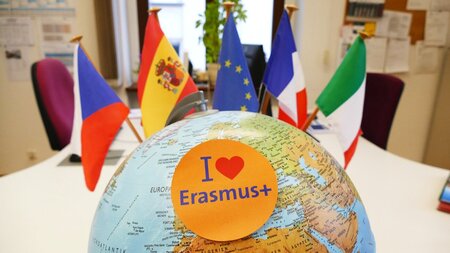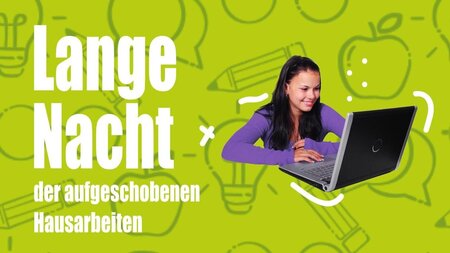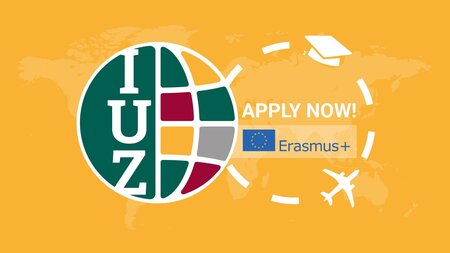Offers for schools
| Contacts: | |
|---|---|
|
Dr. Frank Göring frank.goering@… Phone: +49 371 531 34124 |
Dr. Roman Unger (Computer pool) mrz@… Phone: +49 371 531 34472 |
- Attendance of courses while still enrolled at school.
- Voluntary participation in the examinations at the end of each semester.
- Recognition of the achieved examinations when enrolling as a student.
| Contact: |
|---|
|
Dr. Frank Göring frank.goering@… Phone: +49 371 531 34124 |
| Contacts: | |
|---|---|
|
Dr. Martin Schäfer martin.schaefer@… Phone: +49 371 531 31561 |
Dr. Frank Göring frank.goering@… Phone: +49 371 531 34124 |
| Contact : |
|---|
|
Dr. Martin Schäfer martin.schaefer@… Phone: +49 371 531 31561 |
| Contacts: | |
|---|---|
|
Dr. Martin Schäfer martin.schaefer@… Phone: +49 371 531 31561 |
Dr. Frank Göring frank.goering@… Phone: +49 371 531 34124 |
Online exercise on stochastic/statistics (high school level)
Placement tests for the bridge courses
Math quiz for high school students (Abiturstufe)
| Contact: |
|---|
|
Dr. Franziska Nestler franziska.nestler@… Phone: +49 371 531 32838 |
- Construction of a LEGO Mindstorms robot for path tracking
- Investigation of the mathematical background of the Bastelmathz box
- Examination of the mathematical background of the Spielmathz box
- Ranking in social networks
| Please send written applications to: | |
|---|---|
|
TU Chemnitz Fakultät für Mathematik Dr. Martin Schäfer 09107 Chemnitz Dr. Martin Schäfer martin.schaefer@… Phone: +49 371 531 31561 |
TU Chemnitz Fakultät für Mathematik Dr. Frank Göring 09107 Chemnitz Dr. Frank Göring frank.goering@… Phone: +49 371 531 34124 |
- Strange tiling on the level (Dr. Göring)
- Geometric properties of special tetrahedra (Prof. Martini)
- Chaos and Systems- Creation of modern simulation programs for the content of the book "Chaos and Systems" M.J. Canty (Prof. Junghanns)
- Cauchy-Frobenius-Burnside Lemma (Prof. Potts)
- Programming a ray tracer (Dr. Unger)
| Contacts for interested people: | |
|---|---|
|
Dr. Martin Schäfer martin.schaefer@… Phone: +49 371 531 31561 |
Dr. Frank Göring frank.goering@… Phone: +49 371 531 34124 |
- Postmen and marriage problems (Prof. Christoph Helmberg)
How can a postman use a computer program to determine the shortest circular route that runs through all the streets that the messenger has to visit at least once? The lecture provides an answer to this, in which, in a historical trip from Euler, the task is first shown in an abstract computerized manner on graphs. The next step is the route planning used today in every navigation device with Dijkstra algorithm. In the last step, the mating or marriage problem is explained, which is also used in partner exchanges and with which the best choice of the roads to be crossed for a circular route is made. The lecture ends with an outlook on the related but much more difficult to deal with round trip problem of parcel carriers and its applications. All knowledge required for the lecture is elementary and easy to understand in lower secondary education.
- If someone is planning a trip...(Prof. Christoph Helmberg)
How do you organize a trip with the shortest possible travel time or route so that all planned sights are visited? Such tasks are faced by parcel carriers every day for delivery of the innumerable Internet orders and in many other industrial applications with significantly many items to be visited. Although formulated quickly and easily understandable, the task with the computer in general form is very difficult to solve. The lecture explains the task with its areas of application, gives a first insight into algorithmic complexity considerations, explains some simple approaches for determining cheap round trips with guaranteed quality and finally discusses the basic idea of the currently most powerful methods of linear optimization. Except for the last method, all considerations are elementary, but for a rough understanding of the ideas in the last part, scalar product between vectors is a necessary prerequisite.
- What does a mathematician understand by chaos? (Prof. Peter Junghanns) On the basis of convergent sequence, we examine a population model for its long-term behavior. We use different ways of graphically representing this behavior and discover chaotic behavior of sequences of numbers.
- M.C. Escher - Mathematics and Art (Prof. Horst Martini) The work of the painter M.C. Escher can be divided into three main areas: firstly, it relates to flat ornaments (with artistic variations of the “building blocks”), secondly, to the representation of the three-dimensional geometric conditions, and finally to his very popular, impossible figures, in which the loss of a dimension is trickily exploited in the two-dimensional imaging of three-dimensional figures. In the lecture, these geometric phenomena and their backgrounds are explained in detail.
- The Riemann Hypothesis (Prof. Alois Pichler) "The music of the prime numbers. On the trail of the greatest puzzle in mathematics" is the name of Marcus du Sautoy’s (Univ. Oxford) book on the history of the Riemann Hypothesis. So what is this conjecture that was formulated over 150 years ago? In this lecture we will go on a search of traces: we try to understand the conjecture and also why it is still not understood today.
- Mathematics for life (Prof. Daniel Potts) Computed tomography and magnetic resonance imaging are imaging methods that are considered important medical aids nowadays. These diagnostic methods are based on reconstruction of images to show the structures and functions of the tissues and organs in the body. In computed tomography, the object to be imaged is X-rayed, while magnetic resonance imaging is based on electromagnetic excitation of atomic nuclei. Like a variety of everyday technologies, these methods are based on mathematical processes. The Austrian mathematician Johann Radon created the basis for computed tomography in 1917. Magnetic resonance imaging is crucially based on Fourier analysis, that was initiated by Joseph Fourier (1768-1830). In the lecture there will be explained how computed tomography is made possible by mathematical methods. One focus will be the fast algorithms, which are the basis for compression methods such as MP3 or JPEG.
- How much mathematics is in Talmud? (Prof. Vladimir Shikhman) The Talmud is considered one of the most important works in Judaism. It shows how the legal texts from the Torah were understood and interpreted by rabbis in practice and in everyday life. Many of them deal with legal and economic issues, e.g., if after the insolvency of a debtor, his existing assets are insufficient to settle the total claims. Solving the Talmud’s bankruptcy problem has been a mystery to rabbis for centuries. All attempts to explain failed until the future Nobel Prize winner Robert Aumann applied the principles of mathematical game theory.
- Democracy or autocracy: what does the prohability calculation say? (Prof. Vladimir Shikhman) Which form of government is better, democracy or autocracy? This depends on the likelihood of making a right decision collectively or individually. We present the corresponding mathematical model and, depending on the expertise of the decision-makers, examine whether it is worthwhile to team up or let an individual decide. The Condorcet jury-theorem is explained.
- From Amazon to Netflix: The mathematics of data (Prof. Martin Stoll) What should I stream from Stranger Things after season 2? Which running shoe should I buy best? Recommendation systems have become an integral part of everyday online life. A lot of math is required to process efficiently the underlying large amounts of data and to discover new series, suitable products or love for life. In this lecture we will learn the basics of recommendation systems and some mathematical techniques and terms that allow us to learn from the data.
- Mathematics and signal processing (Prof. Tino Ullrich) MP3, digital photos and videos have become an integral part of our modern world. Almost everyone carries a smartphone with them, which would not exist without math and signal processing. This lecture gives a clear overview of the acquisition, storage and MP3 compression of audio data with music samples. Image compression is also explained step by step using the JPEG format, which is used for image storage in all current cameras and smartphones.
| Contact: |
|---|
|
Dr. Frank Göring frank.goering@… Phone: +49 371 531 34124 |
The bastelMATHz box can be borrowed from the city media office in Chemnitz, the media offices in Freiberg, Zwickau and Plauen and the media education center Annaberg Buchholz. It was first publicly presented on Monday, October 5, 2009, at the Tietz as part of the public award ceremony and exhibition opening of the Mathematics 2009 learning poster competition.






